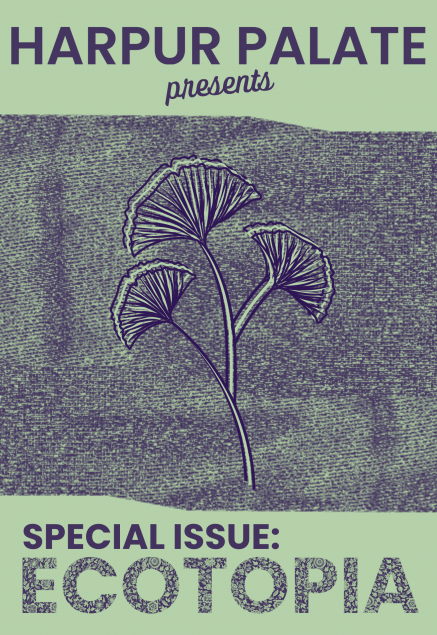Harpur Palate: a Literary Journal

Volume 22, Number 3 (2023) Ecotopia
From the Editor
“If all insects on Earth disappeared, within 50 years all life on Earth would end. If all human beings disappeared from the Earth, within 50 years all forms of life would flourish.”
–Jonas Salk, American virologist and biomedical scientist
The deep future is a black box. With massive environmental changes to our world every decade it is difficult to fathom what Earth will look like in fifty years, let alone five-hundred. However, it is this task, the artist’s calling, to help fill our collective psyche with hopeful imagery to hold onto beyond the all-too-easy symbol of apocalypse. Survival is brilliant. And five mass extinction events thus far have proven to be insufficient to blot it out. Instead, these wonderful creators in Special Issue: Ecotopia present a vision of an ecocentric and sustainable future on Earth that celebrates the human and more-than-human world. Though, this coexistence is not without transformative grief and radical change to where we fit in as a species.
The horizon is where we gaze, falling victim to the illusion that it is the sun, and not us, who moves. Whether Austin Lubetkin’s artwork faces the East or West is up for the viewer to decide. Through its allusion to Casper David Freidrich’s “Wanderer above the Sea of Fog,” “Horizon” places us behind a new being, a woman in a dress, in suspended dance, whose head molds into what appears to be a lamppost, hands and hair tangled (or becoming?) ivy. Rather than symbolizing the intellect above the Earth, this work fuses the human with ecology and industry–a hybrid creature hanging. Even the “crane” in the distance has become organic, its steel neck like decomposing rope, its arm more cloud than metal.
Similar to “Horizon,” Ana Prundaru’s artwork, “Making Time for the Ocean,” superimposes the human head with environmental elements, in this case, the crashing waves cleanly decapitate the heads of those folks in the photo of antiquity. Here, the sea becomes a border not in distance, but in height–a border to the sky, with the story a shredded underworld below, the letters crooked and disembodied from their logic. Suppose we replace our cerebral language (the hubris) with lessons from the sea, to seek, but never achieve, a calmness. The craggy shore beaten for millenia by waves remains sharp–those paradigms of what we believe it means to be human. There is something floating in the water amidst this dadaist frame, but it does not look like a raft.
With “Flourish” by J’Atelier we see a celebration of life. The welcoming and confident gaze of the future via a beautiful young woman amongst an uncanny flock of flamingos on the stone terrace. Blended colors like fire, blue and night sky, drip down the image leaving comics and headlines to peek through without sway. The eye returns to the woman’s candid glance, as if she asks us to follow her, to focus and watch the periphery melt. In essence, distinction may be the enemy. The blending a better way to acknowledge interconnection, like closing one’s eyes makes scent more pronounced. One headline reads: “Spread Your Wings,” leaving the viewer to wonder about escape–the flamingos’ agency. Do those closed eyes wish for flight, or are they by her side by choice?
Our poets responded and expanded upon these artworks in resourceful ways. Josie Levin writes: “It is the land that grieves the hardest,” identifying emotion in the ground our ancestors, nonhuman and human alike, reside in a circular, suspended syntax. Henry Goldkamp troubles our concept of time by flattening the past and present with his phrase: “i remember you as you now,” showing our psychological strain to communicate past the present’s grip. Through quoting seminal poet, Ai, Jen Karetnick quotes: “I’m a wind from nowhere, / a black wave filled with stars,” fusing elements and origin, as if matter was our only home–this body, these words, recycled from poet to poet. Jeffrey Greene senses this displacement, an alien setting, when he writes: “whales roam as if / in another room of a museum,” we, ocularcentric animals, feel our spectatorship of extinction is no longer enough, we might, instead, become the exhibit ourselves. There is great discomfort in change, and facing it with hope may only be possible through community–and collective grief. As Sheree la Puma writes: “In this weird season // a child believes in its mother,” so must we trust the land’s message, our ancestors who spanned six million years in the deep past, and live today, with ambition, that year 2523 will be slow, kind, and enriched with life.
I want to thank these incredible artists for the creativity and inspiration they share with us. As well as the Harpur Palate editors, Hannah Carr-Murphy and James McDermott, for their amazing support.
- Cole Depuy
Poetry
World on purpose
Josie Levin
elegy in a death rattle
Henry Goldkamp
A Few Days After She Fled
Sheree La Puma
Even My Name Suggested Wings
Jen Karetnick
Ode to a Giant Squid
Jeffrey Greene
Art and Photography
"Making Time for the Ocean"
Ana Prundaru
"Flourish"
J'Atelier9 .
Full Issue
Harpur Palate Ecotopia
Harpur Palate .

Editors
- Special Issue Editor In Chief
- Cole Depuy
- Web Editor
- Hannah Carr-Murphy

